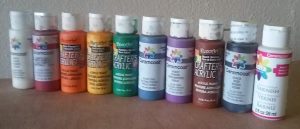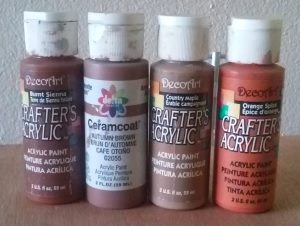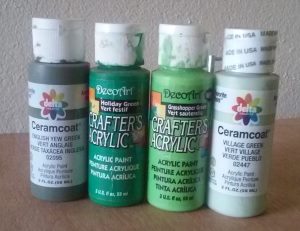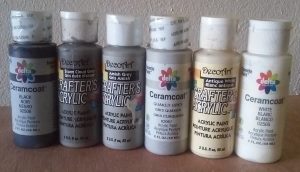Tabletop Officer Training Corp: Showing the Colors
Wednesday , 1, March 2017 Tabletop Games, Wargames 1 Comment
The bare minimum selection.
You’ve got your figures. You’ve got your basic terrain set up. Maybe you’ve played a practice game or two. But things still look flat and dull. When we last left the figures, they were based, primed, and ready for paint. Next time we’re going to look at the single most powerful painting technique that you can master. This week, we’re looking at the supplies you’ll need to apply that technique – the paints. What follows is a basic guide to filling out your paint rack with low cost, good looking paints.
Your friendly local gaming store probably has a rack or two of paints made specifically for wargame figures. One of those racks is filled with paints specifically mixed for the 400-pound wargame juggernaut, Games Workshop. Generally speaking, these paints are high quality and work great on figures, but they are also way over-priced. For those who would rather spend money on more figures and rules than on licensing, a cheaper alternative exists that is easy to find anywhere in the developed world. All of the major craft stores – Hobby Lobby, Michael’s, and Ben Franklin’s, just to name a few – carry an extensive line of acrylic paints that work great on wargame figures. These bottles cost on average a third to half of what you’d pay at the local gaming store, which means you can purchase a wider selection of paints for the same price.

Suitable for fantasy, historic, and terrain.
At a minimum you need the basic colors of the rainbow, black, white, and a decent flesh tone. Acrylic paints are easy to mix, and contain enough paint to cover thousands of wargame figures, so you can use that starting dozen bottles to mix any color that you need. If you’re painting uniforms on figures, you will want to splurge for just the right color; while mixing colors is fast and easy, the mixed paint dries fast, which can make it tricky to match specific shades across a large number of figures.
For example, for the Musketeers game that I’m working on, I made sure to have a nice Hollywood pale blue for the King’s guards, and a rich crimson for the cloaks worn by Cardinal Richelieu. The Three Musketeers figures are carved to represent the ‘renegage’ portion of their career, which in those days means plenty of leather. To make sure the four figures show a consistent color scheme, but also that their colors show as much variety as their figures, I invested in four different shades of brown, one of which is a nice ruddy brown that would be hard to mix.

A good example of the three-tone selection with one hard-to-mix odd ball thrown in for good measure
The three major brands of paint are Ceramcoat, DecoArt, and Apple Barrell. I mix and match the first two brands freely, grabbing bottles based solely on the shade needed at the moment. The Ceramcoat tend to go on a little thicker, and the DecoArt feature brighter highlight colors. My experience with Apple Barrel paints are that they go on thin and require multiple coats to get a decent look, so you won’t see any in my collection.
The best way to flesh out your color selections is to follow the rule of three. For each color, you’ll want to have a basic mid-tone, a darker shade for shadowy areas and variety, and a lighter shade for highlights. As your collection grows, you’ll find numerous instances that demand specific colors. For example, you might want a brilliant fluorescent pink for use with a Cyberpunkish decker. At less than two dollars a bottle, you can get what you need when you need it, and eventually wind up with dozens of shades of every color.
One big exception to the craft store paints rule is metallics. When it comes time to paint silvers, golds, and coppers, the paint you’ll find in the craft stores just won’t cut it. While these paints work well on figures, they aren’t formulated specifically for that purpose. They seem to be made for two-dimensional painting, and so the metallic paints are formulated to look good in that environment. When you can see them on miniatures at all, they look like a cheap dusting of glitter. For swords, guns, armor, and blasters, you need paints formulated for miniatures. They are a little more expensive, but this is one area where you just can’t cut corners.

A few varieties will help you achieve more consistent figures
You also might want to pick up a bottle of matte varnish. Ceramcoat makes a brush-on clear coat that will armor your figures and prevent the normal chipping and fading that can happen with regular use.
Let me say that again, because it cannot be emphasized enough. No matter what basecoat you used on your figures, and no matter how much you spend on the paints used to color them, you MUST apply a protective coating to them. Paints suitable for miniatures are designed to look good, not to hold up to even the lightest use. If you want the paint to stick to the figures, the last step prior to use is either a brush on varnish, a spray on varnish, or both. The spray on varnish – available where ever spray paint is sold – works fast, but doesn’t provide quite as much protection. The brush-on takes longer, but the paint won’t chip even when grubby fingered wargame convention goers drop them onto the tile floors.
Next time, we’ll get started slapping paint on our little heroes.
If one has a local art supply store(not a craft store), I recommend Golden paints. They’re higher quality than the craft store lines, and still cheaper by volume than mini paints.